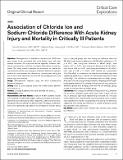Association of Chloride Ion and Sodium-Chloride Difference With Acute Kidney Injury and Mortality in Critically Ill Patients
Author(s)
Kimura, Satoshi; de la Hoz, Miguel Angel Armengol; Raines, Nathan Hutzel; Celi, Leo Anthony G.
DownloadAssociation_of_Chloride_Ion_and_Sodium_Chloride.5.pdf (1.088Mb)
Publisher with Creative Commons License
Publisher with Creative Commons License
Creative Commons Attribution
Terms of use
Metadata
Show full item recordAbstract
Objectives: Derangements of chloride ion concentration ([Cl–]) have been shown to be associated with acute kidney injury and other adverse outcomes. For a physicochemical approach, however, chloride ion concentration should be considered with sodium ion concentration. This study aimed to examine the association of chloride ion concentration and the main strong ion difference (difference between sodium ion concentration and chloride ion concentration) during the first 24 hours after admission into ICU with the development of acute kidney injury and mortality.
Design: Retrospective analyses using the eICU Collaborative Research Database.
Setting: ICUs in 208 hospitals across the United States between 2014 and 2015.
Patients: Critically ill patients who were admitted into the ICU.
Interventions: None.
Measurements and Main Results: A total of 34,801 patients records were analyzed. A multivariable logistic regression analysis for the development of acute kidney injury within 7 days of ICU admission shows that, compared with main strong iron difference 32–34 mEq/as a reference, there were significantly high odds for the development of acute kidney injury in nearly all groups with main strong iron difference more than 34 mEq/L (main strong iron difference = 34–36 mEq/L, odds ratio = 1.17, p = 0.02; main strong iron difference = 38–40 mEq/L, odds ratio = 1.40, p < 0.001; main strong iron difference = 40–42 mEq/L, odds ratio = 1.46, p = 0.001; main strong iron difference > 42 mEq/L, odds ratio = 1.56, p < 0.001). With chloride ion concentration 104–106 mEq/L as a reference, the odds for acute kidney injury were significantly higher only in chloride ion concentration less than or equal to 94 mEq/L and chloride ion concentration 98–100 mEq/L groups. Analyses conducted using inverse probability weighting showed significantly greater odds for ICU mortality in all groups with main strong iron difference greater than 34mEq/L other than the 36–38mEq/L group, as well as in the less than 26-mEq/L group.
Conclusions: Main strong iron difference measured on ICU presentation to the ICU predicts acute kidney injury within 7 days, with low and, in particular, high values representing increased risk. The association between the chloride levels and acute kidney injury is statistically insignificant in models incorporating main strong iron difference, suggesting main strong iron difference is a better predictive marker than chloride on ICU admission.
Date issued
2020-11Department
Massachusetts Institute of Technology. Institute for Medical Engineering & ScienceJournal
Critical Care Explorations
Publisher
Ovid Technologies (Wolters Kluwer Health)
Citation
Kimura, Satoshi et al. "Association of Chloride Ion and Sodium-Chloride Difference With Acute Kidney Injury and Mortality in Critically Ill Patients." Critical Care Explorations 2, 12 (November 2020): e0247 © 2020 The Authors
Version: Final published version
ISSN
2639-8028